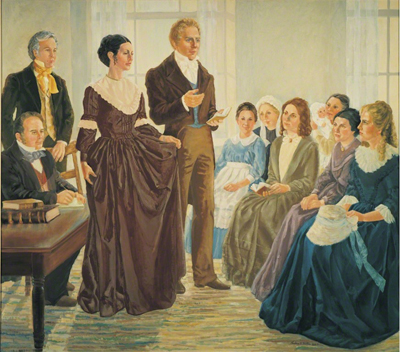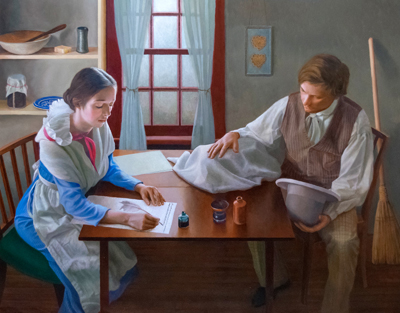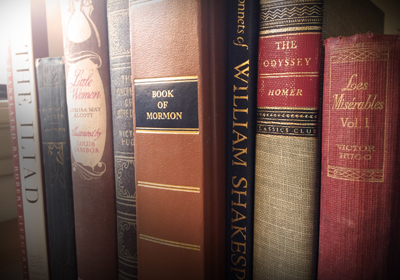
Principle
The Book of Mormon was divinely prepared and preserved for a future dispensation of the gospel. President Ezra Taft Benson declared, “The Nephites never had the book; neither did the Lamanites of ancient times. It was meant for us.”1 Importantly, the book’s primary contributors not only anticipated and prophesied of a future restoration of divine truths, but they foresaw that their sacred record would play a fundamental role in that restoration.
Nephi beheld that after the fullness of the gospel was preached by Jesus Christ and His apostles, there would be the formation of a “great and abominable church” which would take “away from the gospel of the Lamb many parts which are plain and most precious; and also many covenants of the Lord [would be] taken away” (1 Nephi 13:26).2 In a later discourse, Lehi revealed that these truths would be restored when the Book of Mormon and the Bible grew “together, unto the confounding of false doctrines and laying down of contentions, and establishing peace” (2 Nephi 3:12).3
Nephi beheld that the Gentiles and the Jews would be in a “spirit of deep sleep” because the people had “rejected the prophets” (2 Nephi 27:5). Moroni similarly foresaw that a sweeping apostasy would afflict the world (see Mormon 8:26–41). Yet they beheld that the “words of [a] book” (2 Nephi 27:29) would awaken the world and bring about a “restoration to the knowledge of Christ … according to the prayers of all the saints who have dwelt in the land” (Mormon 9:36).
Most importantly, Jesus Christ Himself prophesied about the importance of the coming forth of the Book of Mormon. He taught that the Lord would reveal this record in order to “show forth his power unto the Gentiles” (3 Nephi 21:6) and that it would “be a sign unto them” that the covenant of the Lord was about to be fulfilled (v. 7).4
The Book of Mormon contains patterns of apostasy and restoration.5 It provides a true account of Christ’s ministry after a period of great upheaval and destruction.6 And it accurately depicts Christ’s conferrals of authority as He delivered a new gospel dispensation unto the Nephites.7 What better sign of the Restoration could be given than the miraculous coming forth of an ancient text, one which clearly shows why a restoration was needed and how it would be accomplished?8
Application
Because of its true doctrine and its revelations about sacred ordinances and covenants, the Book of Mormon naturally facilitates personal revelation. President Hinckley declared, “Here is something that a man could hold in his hands, could ‘heft,’ as it were. He could read it. He could pray about it, for it contained a promise that the Holy Ghost would declare its truth if that witness were sought in prayer.”9 In this sense, the Book of Mormon acts as a sign of the Restoration to each individual who sincerely seeks a witness of its truth.10
The Book of Mormon also demonstrates what the Restoration will eventually yield—a people of Zion, whose hearts are filled with the “love of God” (4 Nephi 1:15). 4 Nephi provides a preliminary glimpse at the peace and prosperity that will unfold when the Savior Himself comes to reign among His people: “there were no envyings, nor strifes, nor tumults, nor whoredoms, nor lyings, nor murders, nor any manner of lasciviousness; and surely there could not be a happier people” (v. 16). This authentic historical record shows that true peace and happiness can be restored unto mankind, even while we live in a fallen, mortal world.
With that end in mind, it should be apparent that the Restoration of truth and blessings is still unfolding. President Dieter F. Uchtdorf taught, “Sometimes we think of the Restoration of the gospel as something that is complete, already behind us—Joseph Smith translated the Book of Mormon, he received priesthood keys, the Church was organized. In reality, the Restoration is an ongoing process; we are living in it right now.”11
The Book of Mormon reveals important upcoming events in this ongoing miracle. For instance, Elder Neal A. Maxwell has taught, “Lost books are among the treasures yet to come forth. … We would not even know of the impending third witness for Christ except through the precious Book of Mormon, the second witness for Christ! This third set of sacred records will thus complete a triad of truth.” Elder Maxwell concluded that these combined records would help bring about “a welding together of all the Christian dispensations of human history.”12
Until that time, however, the Book of Mormon will continue to function as the primary sign and evidence of the Restoration. President Ezra Taft Benson called it the “great sifter.”13 Elder Joseph B. Wirthlin called it the “heart of missionary proselyting.”14 And Richard D. Rust described it as being “custom-made for the Restoration.”15 Those who become converted through its powerful messages and everlasting covenants will become converted to Jesus Christ, to the fullness of His Gospel, and to the “divine, prophetic calling of the Prophet Joseph Smith.”16
Further Reading
President Gordon B. Hinckley, “The Marvelous Foundation of Our Faith,” Ensign, November 2002, online at lds.org.
Jeffrey R. Holland, Christ and the New Covenant: The Messianic Message of the Book of Mormon (Salt Lake City, UT: Deseret Book, 1997), 259–261.
Elder Dallin H. Oaks, “Apostasy and Restoration,” Ensign, May 1995, online at lds.org.
President Gordon B. Hinckley, “The Power of the Book of Mormon,” Ensign, June 1988, online at lds.org.
- 1. President Ezra Taft Benson, “The Book of Mormon—Keystone of Our Religion,” Ensign, November 1986, online at lds.org.
- 2. For further information about the Great Apostasy see, Noel B. Reynolds, ed., Early Christians in Disarray: Contemporary LDS Perspectives on the Christian Apostasy (Provo, UT: BYU Press and FARMS, 2005).
- 3. Lehi was quoting here from Joseph who was sold into Egypt. For further information on the relationship between these two records, see Book of Mormon Central, “Why Is There a Need for the Testimony of Two Nations? (2 Nephi 29:28),” KnoWhy 56 (March 17, 2016).
- 4. See Book of Mormon Central, “Who is the Servant Spoken of by Christ? (3 Nephi 21:10),” KnoWhy 215 (October 24, 2016).
- 5. The Book of Mormon shows dramatic and cyclical shifts towards and away from righteousness. See Book of Mormon Central, “How did the Nephites Become Weak in Such a Short Time? (Helaman 4:25),” KnoWhy 175 (August 20, 2016); Book of Mormon Central, “How did the ‘Pride Cycle’ Destroy the Nephite Nation? (3 Nephi 6:10),” KnoWhy 195 (September 26, 2016).
- 6. See Book of Mormon Central, “Why Has 3 Nephi Been Called ‘The Focal Point, The Supreme Moment’ in the Book of Mormon? (3 Nephi 11:10),” KnoWhy 201 (October 4, 2016); Book of Mormon Central, “Why is 3 Nephi Sometimes Called the ‘Fifth Gospel’? (3 Nephi 27:21),” KnoWhy 222 (November 2, 2016).
- 7. See Jeffrey R. Holland, Christ and the New Covenant: The Messianic Message of the Book of Mormon (Salt Lake City, UT: Deseret Book, 1997), 259–260: “Although these Nephites had authority to baptize in the old Mosaic dispensation, Christ invited Nephi forward to affirm his priesthood authority to baptize in the new gospel dispensation, and perhaps to ordain him to the apostleship at the same time.”
- 8. See Book of Mormon Central, “Why Did the Book of Mormon Come Forth as a Miracle? (2 Nephi 27:23),” KnoWhy 273 (February 10, 2017).
- 9. President Gordon B. Hinckley, “The Marvelous Foundation of Our Faith,” Ensign, November 2002, online at lds.org.
- 10. See Book of Mormon Central, “How Will God Manifest the Truth of the Book of Mormon? (Moroni 10:4),” KnoWhy 254 (December 16, 2016).
- 11. President Dieter F. Uchtdorf, “Are You Sleeping through the Restoration?” Ensign, May 2014, 59, online at lds.org.
- 12. Elder Neal A. Maxwell, “‘God Will Yet Reveal,’” Ensign, November 1986, online at lds.org.
- 13. President Ezra Taft Benson, “Jesus Christ—Gifts and Expectations,” Ensign, December 1988, online at lds.org.
- 14. Elder Joseph B. Wirthlin, “The Book of Mormon: The Heart of Missionary Proselyting,” Ensign, September 2002, online at lds.org.
- 15. Richard Dilworth Rust, “‘I Know Your Doing’: The Book of Mormon Speaks to Our Times,” Ensign, December 1988, online at lds.org.
- 16. Elder Wirthlin, “The Book of Mormon: The Heart of Missionary Proselyting,” online at lds.org.
Continue reading at the original source →






